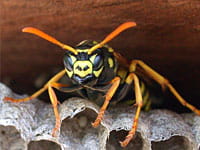3 tips to keep pests out of your garden
As the middle of summer approaches, you need to be vigilant about keeping your garden free of pests. Many insects breed during the summertime, which means they're on the lookout for great places to lay their eggs. For many bugs, that means near a source of food. In fact, some species of insects will lay their eggs inside budding vegetables and fruit so their larvae have something to eat as soon as they hatch. That's why you have to keep harmful bugs out without damaging the bugs that could help you, such as bumble bees.
